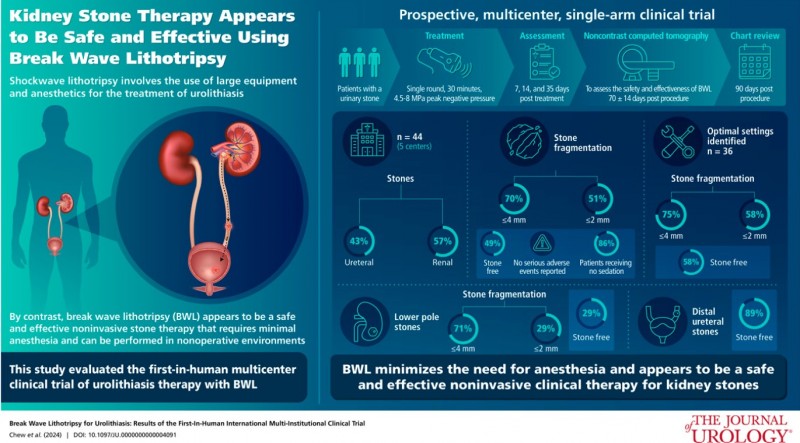Portable Ultrasound Technology Found Safe, Effective for Treating Urinary Stones
Images

According to results of a clinical trial published in The Journal of Urology, a noninvasive ultrasound technology called Break Wave lithotripsy (BWL) offers a safe and effective new option for treatment of urinary stones.
"In this initial experience, BWL provided a high treatment success rate, using a portable technology that can be used in a range of settings, without the need for anesthesia," comments lead author Ben H. Chew, MD, MSc, of the University of British Columbia, Vancouver, Canada.
Urinary stones are a common clinical problem and a major reason for emergency department (ED) visits. Treatment options include surgery (ureteroscopy) or, for some patients, extracorporeal shockwave lithotripsy (SWL), which uses high-pressure ultrasound waves to fragment stones so they can pass through the urinary system. Although SWL is noninvasive and effective, it has some disadvantages: the equipment is large and expensive, and the procedure usually requires some kind of anesthesia and a surgical suite.
Rather than shockwaves, BWL uses low-pressure ultrasound waves to target and fragment urinary stones. Break Wave lithotripsy is delivered using a smaller and less costly mobile unit, allowing treatment to be performed in a range of locations outside of an operating room. In 2022, the BWL system received Breakthrough Device Designation from the US FDA.
Dr. Chew and colleagues report the "first-in-human" clinical trial of BWL. The study included 44 patients at five hospitals across North America with stones located in the kidney (57% of patients) or ureter (43%). All patients chose to undergo BWL after discussion of other options (ureteroscopy or conventional SWL). Stones were treated for a total of 30 minutes under real-time ultrasound targeting.
Break Wave lithotripsy was effective, with evidence of fragmentation in 88% of patients. After treatment, most patients had fragments small enough to pass through the urinary system: four millimeters or less in 70% of patients and two millimeters or less in 51%. On follow-up CT scans, 49% of patients were completely stone-free.
After the first several cases, 36 patients were treated with "optimized" ultrasound dose settings, achieving a fragmentation rate of 92%. Seventy-five percent of patients had fragments measuring four millimeters or less, while 58% were completely stone-free. As expected, success rates were higher for patients with stones located in the distal ureter, compared to stones in the lower pole of the kidney. Complications were generally mild, with no serious adverse events.
Through 90 days' follow-up, only seven percent of patients required further treatment for the target stone. In most patients, BWL could be performed without anesthesia – either with no medications or only a mild pain reliever. In four patients with severe, acute pain, BWL was successfully carried out in the ED.
In this initial clinical study, BWL appears to be a safe and effective new option for treatment of urinary stones. Treatment can be conveniently performed in the ED, medical office, or other settings, without the need for anesthesia or sedation. Dr. Chew comments: "The BWL technique – together with other developing technologies such as ultrasonic propulsion – has the potential to provide effective, noninvasive treatment for patients with kidney and ureteral stones, reducing resource burdens and enabling more timely care."